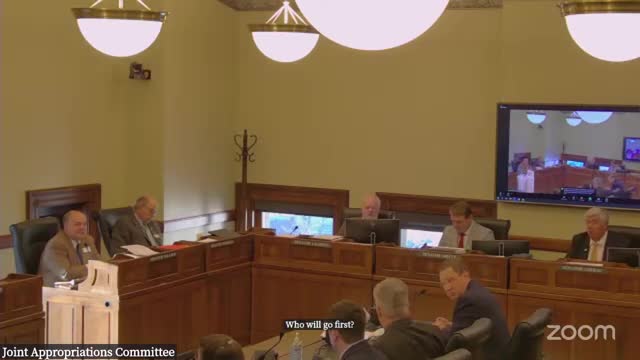January Craig report trims oil forecast, shifts school funding outlook
January 16, 2025 | Appropriations, Joint & Standing, Committees, Legislative, Wyoming
This article was created by AI summarizing key points discussed. AI makes mistakes, so for full details and context, please refer to the video of the full meeting. Please report any errors so we can fix them. Report an error »

The state’s consensus revenue estimating group reduced its 2025 oil‑price forecast by $5 a barrel to $65 and made accounting and production adjustments that together produce a modest decline to general operations and a sizable negative revision for K‑12 funding, presenters told the Joint Appropriations Committee Thursday.
Don Richards of the Legislative Service Office, appearing as co‑chair of the consensus revenue estimating group, said the January revisions included the $5 per‑barrel oil‑price reduction, a 1,000,000‑barrel upward revision to 2026 production, adjustments to permanent fund beginning market values, and a reduction in state royalties tied to lower production on state lands.
"Our forecasts are not for tomorrow's price, not for next week's price, but the calendar year average," Richards said, explaining the group’s decision to lower the 2025 price despite short‑term market swings. He noted that a $5 per‑barrel reduction in the forecast translates into roughly a $64 million reduction across accounts: about $26 million to the School Foundation Program, about $26 million to the general fund, and the remainder affecting deposits to permanent funds.
Richards also told the committee that realized capital gains of about $105 million existed at the time of the report but that the consensus group does not forecast capital gains; realized gains are acknowledged but not built into the baseline forecast. He said the group had also reduced state royalty expectations by about $21 million for fiscal years 2025 and 2026 after coal and oil production on state lands came in lower than expected; roughly two‑thirds of that ($14 million per year) is deposited to the common school permanent land fund and one‑third ($7 million) reduces the amount available in the school foundation profile.
On aggregate, Richards summarized the net impacts as a general‑operation decline of $11,550,000 and a negative adjustment on the school side of approximately $96,100,000 driven largely by an accounting alignment between Craig and local school district forecasts.
Kevin Hibbard, listed as the executive‑branch co‑chair on the report, thanked Richards and staff for the work of the group; Richards and Hibbard noted the long‑standing purpose of the Craig process to produce a consensus revenue baseline for the legislature.
Committee members pressed staff on whether a potential shortfall would force use of LSRA (the school account) backstops. Richards said the state does not anticipate using the LSRA backstop this year, noting an estimated ending balance of roughly $170 million even after the governor’s recommendations. The presenters also emphasized the volatility inherent in forecasting commodity prices and production volumes.
The Craig report’s tables and underlying detail were provided to committee members in the packet; Richards directed members to page 7 of the January report for a line‑by‑line distillation of the revisions.
Don Richards of the Legislative Service Office, appearing as co‑chair of the consensus revenue estimating group, said the January revisions included the $5 per‑barrel oil‑price reduction, a 1,000,000‑barrel upward revision to 2026 production, adjustments to permanent fund beginning market values, and a reduction in state royalties tied to lower production on state lands.
"Our forecasts are not for tomorrow's price, not for next week's price, but the calendar year average," Richards said, explaining the group’s decision to lower the 2025 price despite short‑term market swings. He noted that a $5 per‑barrel reduction in the forecast translates into roughly a $64 million reduction across accounts: about $26 million to the School Foundation Program, about $26 million to the general fund, and the remainder affecting deposits to permanent funds.
Richards also told the committee that realized capital gains of about $105 million existed at the time of the report but that the consensus group does not forecast capital gains; realized gains are acknowledged but not built into the baseline forecast. He said the group had also reduced state royalty expectations by about $21 million for fiscal years 2025 and 2026 after coal and oil production on state lands came in lower than expected; roughly two‑thirds of that ($14 million per year) is deposited to the common school permanent land fund and one‑third ($7 million) reduces the amount available in the school foundation profile.
On aggregate, Richards summarized the net impacts as a general‑operation decline of $11,550,000 and a negative adjustment on the school side of approximately $96,100,000 driven largely by an accounting alignment between Craig and local school district forecasts.
Kevin Hibbard, listed as the executive‑branch co‑chair on the report, thanked Richards and staff for the work of the group; Richards and Hibbard noted the long‑standing purpose of the Craig process to produce a consensus revenue baseline for the legislature.
Committee members pressed staff on whether a potential shortfall would force use of LSRA (the school account) backstops. Richards said the state does not anticipate using the LSRA backstop this year, noting an estimated ending balance of roughly $170 million even after the governor’s recommendations. The presenters also emphasized the volatility inherent in forecasting commodity prices and production volumes.
The Craig report’s tables and underlying detail were provided to committee members in the packet; Richards directed members to page 7 of the January report for a line‑by‑line distillation of the revisions.
View full meeting
This article is based on a recent meeting—watch the full video and explore the complete transcript for deeper insights into the discussion.
View full meeting